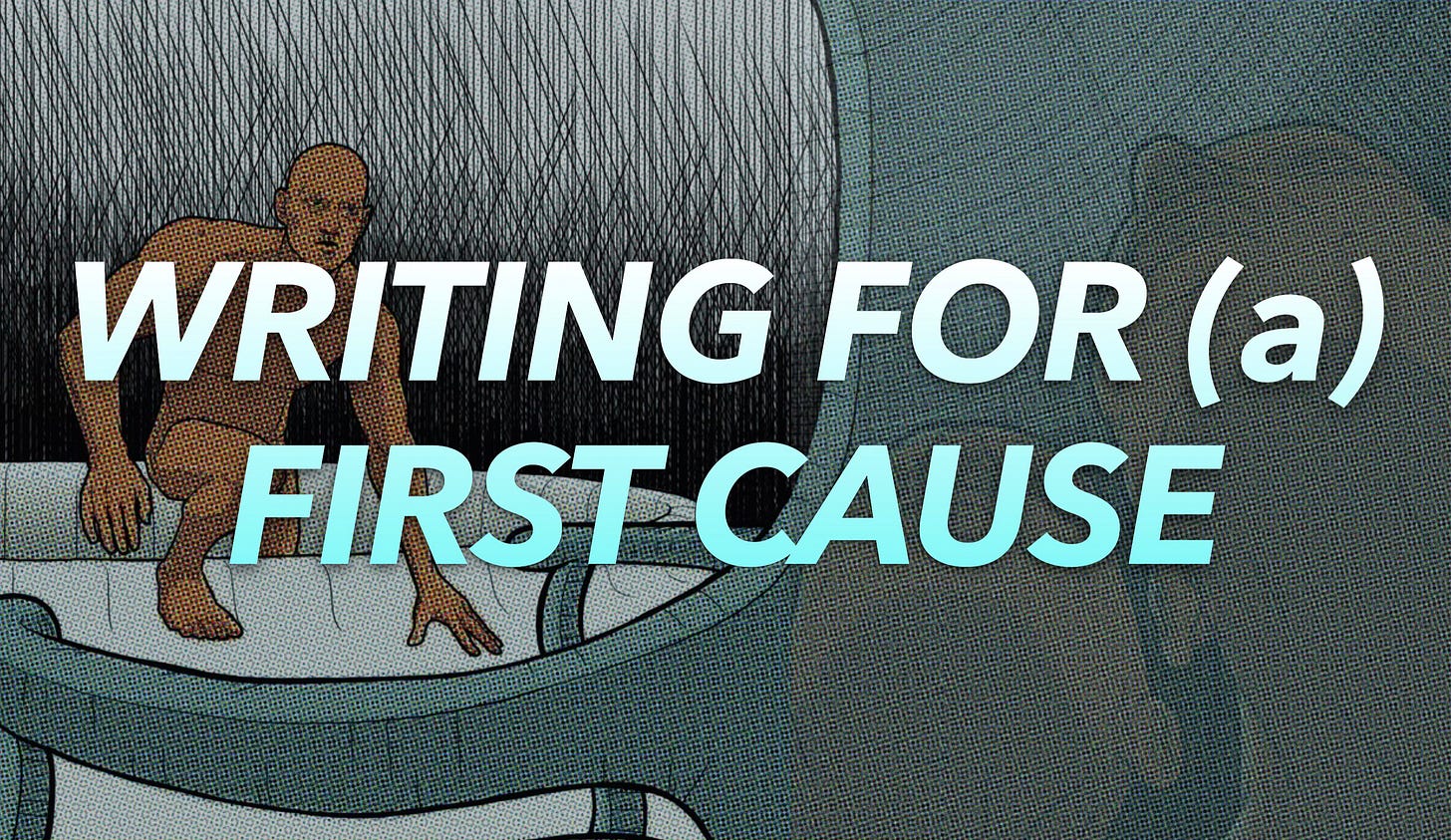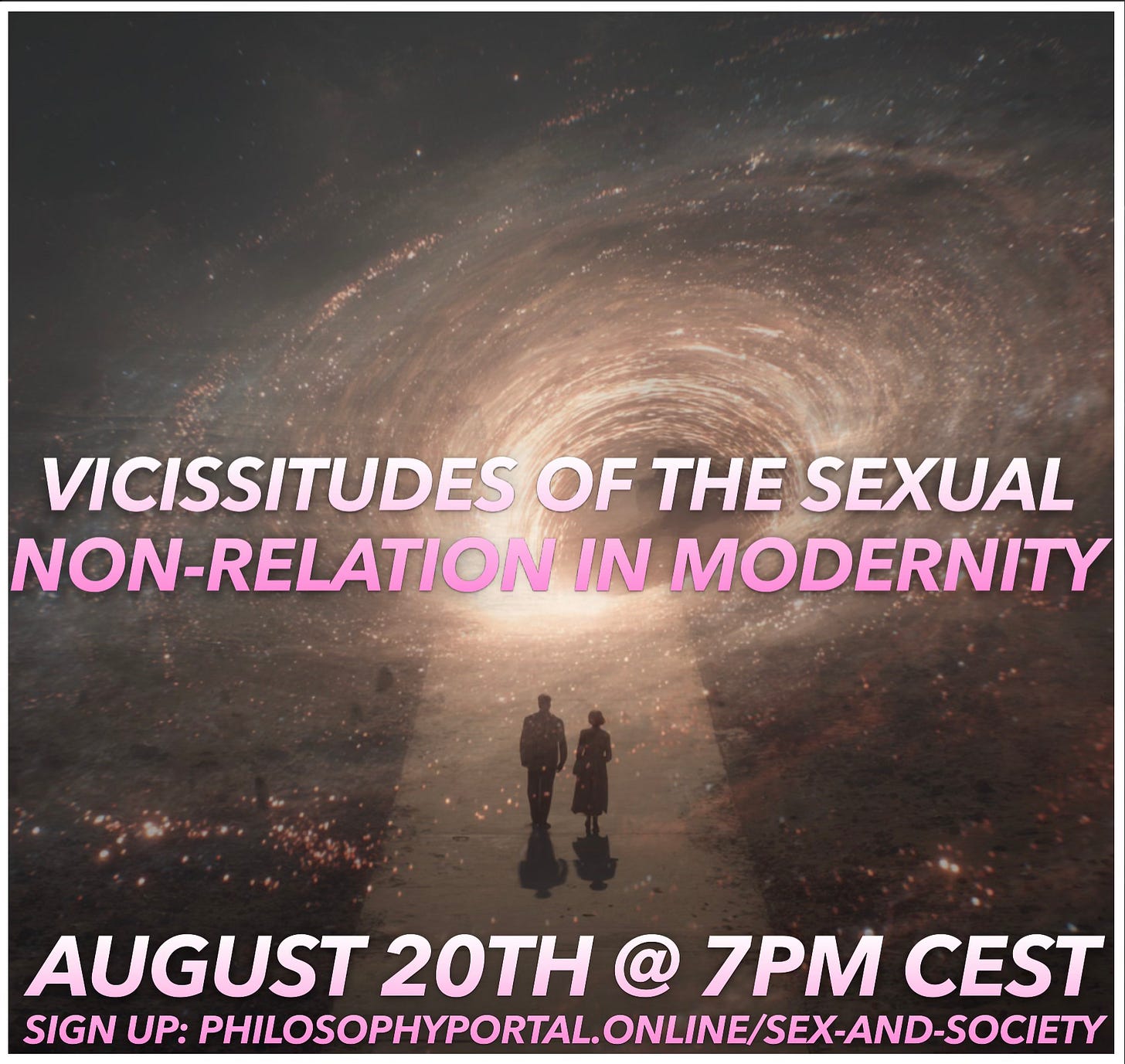This month Philosophy Portal released its fourth anthology, titled Writing For (a) First Cause. You can find out more about this anthology, or pick up a copy, below:
Tonight in The Portal,
hosts the second “Sex and Society” session titled “Vicissitudes of the Sexual Non-Relation in Modernity”. To learn more or to get involved, check the link below:The following is a reproduction of the opening note in Writing For (a) First Cause:
Jacques Lacan’s Écrits, his writings, represents the analyst’s most philosophical moment.1 These works were published at the height of what is often referred to as his “symbolic phase”, in-between 1963 and 1969, when he was teaching at the École normale supérieure, an advanced educational institute in Paris. The papers themselves are a collection that span over a decade of work, from texts originally written in 1955 like “The Freudian Thing” — which outlines the stakes of Lacan’s “Return to Freud”2 — to papers written in 1966 like “Science and Truth” — which frames the analytic relation to not only science, but religion, magic, and the philosophical notion of causation in general.3
However, in discussing the stakes of reading Lacan’s Écrits today, it may be best to represent the work, not in terms of clock time, that is the linear sequence that we usually use to measure duration, but in terms of logical time. Logical time was a concept introduced by Lacan in the Écrits, and specifically in the incredibly dense and almost impenetrable paper “Logical Time and the Assertion of Anticipated Certainty”.4 Logical time can be broken down into three separate elements representing three logical moments of psychical temporality:
The Instant of Seeing,
The Time for Understanding, and
The Moment of Concluding
In regards to Lacan’s entire career, the Écrits can be situated clearly as the key logical moment of his own “Time for Understanding”. What was he trying to understand? He was trying to understand his “instant of seeing” the formation of ego psychology in post-Freudian schools that increasingly reified analytic ego-reality as the standard of “mental health” or “psychic well-being”. This move instituted a false positive which dramatically reduced the capacity for analysis to deal with the real truth of negative excess. For Lacan, this was a psychoanalytic catastrophe, closing the (arousing and yet anxiety provoking) gap that Freud opened up in his discovery of the unconscious.
Consequently, most of what Lacan is writing about in the Écrits is directed against this central enemy: “ego psychology” as a false positive. But that does not exhaust the work. Lacan also attempts to work out what would be a genuinely Freudian approach to psychoanalytic training of clinicians. What we should never overlook when reading Lacan is that his work is primarily directed towards the training of clinicians under the open-question: do analysts even exist? For Lacan, most of the clinicians working in the Freudian tradition did not understand the crucial developments internal to Freud’s own teaching, and as a result, the institutions he opened had not only failed to live up to the master’s own standard, but had regressed to a type of pre-Freudian scientific psychology.
What were these key Freudian teachings?
Lacan starts his project in the transitions that occur in Freud between his focus on narcissism as a type of auto-erotic pleasure which disregards reality,5 and his focus on the death drive as the “beyond” of the “pleasure principle” which opens up a threatening negative excess.6 What happens to Freudian analysis between these moments is a disturbing repetition of something unpleasurable or undesired as a consequence of following pleasure beyond “reality as limit” to the disorienting “extremes of pleasure”.7 What is more disturbing: this repetition of something unpleasurable or undesired was also something deadly, violent and aggressive from the perspective of the ego, a form of self-destruction that threatens to undermine subjective mediation.
In short: Lacan starts the Écrits with the thought that ego psychology had replaced the real of the death drive, and the disturbing nature of what he would call jouissance (as the extreme of pleasure), with the analyst's ego-reality. This move easily accommodated processes of institutionalisation under the guise of a scientific psychology, but failed the subject of the unconscious. In this way, the imaginary of the analyst's ego-reality was keeping the clinic in a type of child-like immediacy, destroying the conditions of possibility for subjects to mediate the transition from the imaginary to the symbolic to the real (via working with the death drive). This dangerous path is required to escape the dyadic imaginary capture between the ego’s desire and its impossible Other, which necessitated psychoanalysis in the first place.
While this helps us grasp Lacan’s “time for understanding” (mediation of clinicians) as a response to his “instant of seeing” (formation of ego-psychology), we now need to focus on the way in which Lacan arrives at his “moment of concluding”. We could say that Lacan’s “moment of concluding” involves thinking through the very basic formulas of the transition from desire — represented with the algorithm $<>a8 — to the drive — represented with the algorithm $<>Ð.9
Although it is well-known that a lot of time and attention was put into establishing the opening of the Écrits as framing the stakes of imaginary capture (Section 1: “Overture to this Collection” and “Seminar on “The Purloined Letter””) — most notably framed with the L Schema,10 what is less well-known is that it seems an equal amount of time and attention was put into establishing the end of the Écrits. The end of the Écrits can be understood as constituted by a movement from (imaginary) desire to (the real of the) drive (Section 7: “The Subversion of the Subject and the Dialectic of Desire in the Freudian Unconscious”, “Position of the Unconscious”, “On Freud’s “Trieb” and the Psychoanalyst’s Desire”, and “Science and Truth”) — most notably framed with the Graph of Desire.11 While the L Schema establishes the matrix in which ego-psychology traps the subject in an imaginary capture and forecloses the signifying locus of the missing Other, the Graph of Desire establishes the sacrifice of jouissance which opens up the condition of possibility for the drive of real signification.
But we should consider Section 7, the ending of the Écrits, in all of its details.
First, “The Subversion of the Subject and the Dialectic of Desire in the Freudian Unconscious” seems to orbit around accepting symbolic castration as refusing jouissance in order to attain jouissance on the inverse scale of the law of desire;12 second, the “Position of the Unconscious” seems to orbit around instantiating a new mythological real of lamella in the separation from the afterbirth (as opposed to the standard Oedipal mythology regarding the imaginary Mother as ultimate real);13 third, “On Freud’s “Trieb” and the Psychoanalyst’s Desire” seems to orbit the importance of an analysis that escapes the mythological desire of the lost object;14 and the central conclusion of “Science and Truth” seems to be about the being missing its other-half which approaches analysts in the clinic as exiting Plato’s Cave and reconciling with the lack of a symmetrical phallus.15
The first proposition is important for instantiating the logic of the negation of the negation at the ground of a psychoanalytic process which moves beyond itself. The second proposition is important for forwarding a mythology that makes it impossible to blame an Other human being who does not exist. The third proposition is important for avoiding the clinical temptation of framing one’s own ego as the lost object of desire. Finally, the fourth proposition situates the analytic project as sublating the ancient philosophical project which struggles with the asymmetry at the heart of sexual difference.
All of the papers in Section 7 combined can be understood to point in the following direction:
The imaginary jouissance of the original Other is impossible and must be refused in order to reconcile oneself with the drive beyond clinical analysis capable of instantiating new modern myths for scientific civilization
When we consider Lacan’s Écrits in light of this summary, it is easy to see that the stakes of reading this work are just as high today, if not higher, than when Lacan originally published it.
To pick up a copy of Writing For (a) First Cause, see:
To join The Portal’s Sex and Society sharing circle, see:
The first part of the article was originally published in Paletten magazine: Last, C. 2024. Imaginary to the Real and Back: Stakes for Re-Reading Lacan’s Écrits Today. Paletten, Nr. 335-336. p. 17-20.
Lacan, J. 2005. The Freudian Thing or the Meaning of the Return to Freud in Psychoanalysis. In: Écrits: The First Complete Edition in English. p. 334-363.
Lacan, J. 2005. Science and Truth, In: Écrits: The First Complete Edition in English. New York: W.W. Norton & Company. p. 726-745.
Lacan, J. 2005. Logical Time and the Assertion of Anticipated Certainty, In: Écrits: The First Complete Edition in English. New York: W.W. Norton & Company. p. 161-175.
Freud, S. 1914. Narcissism: An Introduction. In: Complete Works, p. 2931-2954.
Freud, S. 1930. Beyond the Pleasure Principle. In: Complete Works, p. 3740.
Lacan, J. 2005. Beyond the “Reality Principle”. In: Écrits: The First Complete Edition in English. New York: W.W. Norton & Company. p. 58.
Barred subject’s desire for an object-cause of desire.
Barred subject’s desire for desire itself (drive). Note: the modification of the notation for demand (D) to drive (Ð) is influenced and inspired by the work of
in his seminars for Philosophy Portal “Deleuze and Analysis” in 2025.Lacan, J. 2005. Seminar on “The Purloined Letter”. In: Écrits: The First Complete Edition in English. New York: W.W. Norton & Company. p. 40.
Lacan, J. 2005. The Subversion of the Subject and the Dialectic of Desire in the Freudian Unconscious. In: Écrits: The First Complete Edition in English. New York: W.W. Norton & Company. p. 692.
Ibid. p. 700.
Lacan, J. 2005. Position of the Unconscious. In: Écrits: The First Complete Edition in English. New York: W.W. Norton & Company. p. 716-720.
Lacan, J. 2005. On Freud’s “Trieb” and the Psychoanalyst’s Desire. In: Écrits: The First Complete Edition in English. New York: W.W. Norton & Company. p. 723-4.
Lacan, J. 2005. Science and Truth. In: Écrits: The First Complete Edition in English. New York: W.W. Norton & Company. p. 744-5.



